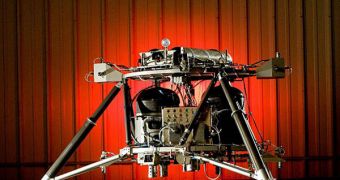The American space agency has been developing a new lunar lander concept for quite some time now, and some of the systems that will go on the new spacecraft have been successfully tested at a private company's simulating facility, in Alabama.
NASA conducts the Lunar Lander Project out of its Marshall Space Flight Center (MSFC), in Huntsville, Alabama. In support of this endeavor, the test facility owned by Teledyne Brown Engineering, also in Huntsville, supported the new investigation.
Engineering teams at both the company and the agency worked together to carry out the integrated and completed system testing stage for the new prototype's sensors, onboard computer, and thrusters.
Basically, this represents a huge section of the spacecraft per se, NASA officials say. If these systems behave well, then the number of things that could fatally jeopardize the mission drops considerably.
Using modified skateboards and a customized track system, engineers developed a low-cost solution for controlling the movements of the lander's prototype. This is the setup that was used for the new functional tests.
The main goal here was to ensure that all the components can work seamlessly with each other, collaborating to relay data that would enable the onboard computers to sense the lander's movements, and compensate for them accordingly.
At this point, strap-down tests are scheduled to be conducted later in the year at the United States Army Redstone Arsenal Test Center in Huntsville, with which NASA has entered a partnership.
“The lander prototype will aid NASA’s development of a new generation of small, smart, versatile landers for airless bodies such as the Moon and asteroids,” a NASA press release says.
“The lander's design is based on cutting-edge technology, which allows precision landing in high-risk, but high-priority areas, enabling NASA to achieve scientific and exploration goals in previously unexplored locations,” the statement adds.
The Robotic Lunar Lander Development Project is developed by the MSFC, the Laurel, Maryland-based Johns Hopkins Applied Physics Laboratory (JHU-APL), and the Von Braun Center for Science and Innovation.
The Center includes Science Applications International Corporation, the Dynetics Corp., Teledyne Brown Engineering Inc., and Millennium Engineering and Integration Company, all of which are based in Huntsville.

 14 DAY TRIAL //
14 DAY TRIAL //